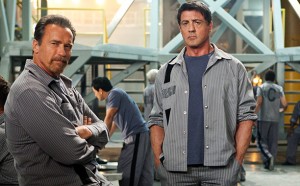When the Game Stands Tall
Posted on August 21, 2014 at 5:59 pm
C| Lowest Recommended Age: | Middle School |
| MPAA Rating: | Rated PG for thematic material, a scene of violence, and brief smoking |
| Profanity: | Mild language |
| Alcohol/ Drugs: | Smoking |
| Violence/ Scariness: | Shooting, very sad death, serious illness, parental abuse, tense confrontations |
| Diversity Issues: | Diverse characters |
| Date Released to Theaters: | August 22, 2014 |
 This dreary assemblage of every possible sports cliché has one thing in common with the game it portrays. Every time it seems to be going somewhere, it stops.
This dreary assemblage of every possible sports cliché has one thing in common with the game it portrays. Every time it seems to be going somewhere, it stops.
More frustratingly, it wastes the opportunity to tell a good story by trying to squeeze in too many great ones. There are too many crises, too many story arcs, too few resolutions, too few reasons for us to invest in the outcome. When a movie is based on (or even “inspired by”) something that really happened, the first step has to be deciding what the theme is and streamlining all of the real-life details that are not central to that theme. Or, as a coach might say, “Don’t lose focus.”
The real-life high school football team that inspired this story is Concord, California’s De La Salle Spartans, from a small, all-boys Catholic school. They hold the all-time winning streak record for any sport in any category and at any level. We meet the team just as the streak is about to end. The last game of the season is the 151st win in a row. But then Coach Bob Ladouceur (Jim Caviezel) has a heart attack. A player is killed in a drive-by shooting. Another one becomes an orphan, responsible for his younger brother. The other teams do not want to play the Spartans anymore, so they take on the number one team in the state (in a game that is the subject of a book. The winning streak that went from 1992-2004 came to an end.
That’s an interesting place for a sports movie to begin, a refreshing change from the over-familiar sports movie storyline of a scrappy group of underdogs who have to learn to work together. And the film is sincere and good-hearted, though not much we haven’t learned from reading Kipling’s If, especially the part about understanding that winning and losing are both imposters. But the dramatic force of the narrative keeps being mowed down by so many over-familiar sports movie lines that the film’s greatest appeal may be as a drinking game. How many times do we have to hear about how the teammates are family, especially when we hear it more than we see it? (Though I did enjoy seeing the team come on the field holding hands like a kindergarten field trip.)
There is a lot to explore here about what we learn from winning and how much more we learn from losing. Ladouceur’s techniques include “commitment cards” with training goals, practice goals, and game goals, each one written by a player and shared with a teammate to help them understand they are responsible for each other’s performance as well as their own. It is good to hear a coach say that end zone antics are inappropriate and that the purpose of the training is not to produce great high school football players but responsible men.
A number of issues are set up or glancingly referred to without any real connection or follow-through, including some of the coach’s lessons about what matters more than winning. The coach’s son says that when he needed a dad he got a coach and when he needed a coach all he got was a “lame dad.” The coach’s wife (a criminally under-used Laura Dern) says he does not share himself with her or their children. Ladouceur acknowledges that he has been “a bad husband and a worse dad.” But all we see as a response is Ladouceur burning some burgers when he tries to grill.
We do not get enough of the history between the two players who struggle over whether they will stay together through college for it to be meaningful. A brutish father (Clancy Brown) pushes his quarterback son to break the state record in scoring, but the resolution is not set up in a way that makes it a triumph for anyone. Intrusive product placement from a sporting goods store is a distraction as well. As though to keep us on track, equally intrusive sports announcers keep reminding us what the stakes are. Even more intrusive is a musical score that is ploddingly obvious, with hip-hop in a black player’s home and syrupy pop over the white characters. Meanwhile, over on the sidelines (literally), Michael Chiklis as the assistant coach turns in the film’s most intriguing performance.
“It’s no longer about who the bigger, stronger, faster players are,” the coach who has the bigger, stronger, faster players says about playing against the Spartans. (You can tell what’s coming next, right?) “It’s about who plays with more heart.” The heart in this film is mostly over the end credits, where we see the truly inspirational Ladouceur and wish we had just seen a documentary about him instead.
Parents should know that this film includes the tragic murder of a teenager, serious illness of a parent, death of a parent, parental abuse of a teenager, scenes of wounded warriors in rehab, smoking, and brief crude sexual references
Family discussion: What goals will you put on your commitment card? Why didn’t the coach want his players to pay attention to the streak? What was his most important lesson?
If you like this, try: “Friday Night Lights” (the movie and the television series) and “Remember the Titans,” as well as the books about the Spartans: When the Game Stands Tall: The Story of the De La Salle Spartans and Football’s Longest Winning Streak and One Great Game: Two Teams, Two Dreams, in the First Ever National Championship High School Football Game

